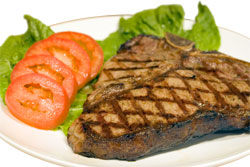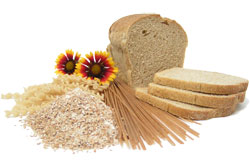Introduction to nutrition
- Essential nutrient requirements
- Glycaemic index and glycaemic load
- Special features about men and nutrition
- Ways to maintain a healthy lifestyle
- Enjoy a wide variety of nutritious foods
- Eat plenty of vegetables, legumes and fruits
- Eat plenty of cereals, preferably wholegrain
- Include lean meat, fish, poultry and/or alternatives
- Include milks, yoghurts, cheeses and/or alternatives
- Drink plenty of water
- Limit saturated fat and moderate total fat intake
- Choose foods low in salt
- Limit your alcohol intake if you choose to drink
- Consume only moderate amounts of sugars and foods containing added sugar
Introduction to nutrition
Over the past few decades, there have been conflicting ideas about what constitutes healthy eating. This has resulted in many opinions on what makes up healthy food choices and good nutrition. Nutrition is defined as the processes by which an animal or plant takes in and utilises food substances. Essential nutrients include protein, carbohydrate and fat in varying amounts, as well as electrolytes (substances like sodium). Normally, 85% of daily energy use is from fat and carbohydrates and 15% from protein. In humans, nutrition is mainly achieved through the process of putting foods into our mouths, chewing and swallowing it. The required amounts of the essential nutrients differ by age and the body’s state. In men, required components of nutrition are affected by physical activity, composition of diet, diseases present (eg. prostate cancer), and drugs.
Essential nutrient requirements
Energy
For weight to remain stable, the total amount of calories that are consumed must not exceed the total that we use up through metabolic processes (such as exercising, sweating and breathing). Energy intake must match energy output.
The average energy intake is about 2800 kcal/d for men, although these estimates vary with body size and activity level.
Protein

For adults, the recommended dietary allowance for protein is about 0.6 g/kg body weight per day. Animal proteins tend to include highest amounts of proteins, followed by legumes (beans), cereals (rice, wheat, corn), and roots.
The male human body requires more protein during growth and when recovering from a state of malnutrition. In some disease states such as liver disease and kidney disease, the amount of protein consumed must be watched. In liver disease such as cirrhosis (increased fibrous tissue, nodules and disruption of the liver structure) normal protein intake can result in a state of confusion.
Fats
Fats are a concentrated and rich source of energy. It is recommended that fat intake total no more than 30% of calories. Saturated fat and trans-fat should be limited to less than 10% of calories, and polyunsaturated fats to less than 10% of calories. The rest of the fat intake should consist of monounsaturated fats.
- Trans fats: These fats are artificially created through a chemical process. This solidifies the oil and limits the body’s ability to regulate its cholesterol. These fats are considered to be harmful to your health. Trans fats are found mainly in deep-fried fast foods and processed foods made with margarine.
- Saturated fats: This type of fat is found in foods such as butter and beef fat.
- Polyunsaturated fats: This group includes omega 3 and 6 essential fatty acids (EFA’s).There are high levels found in fish oil, vegetable and nut oils.
- Monounsaturated fatty acids: This is found mainly in chicken fat and vegetable oils such as olive, canola and peanut oil.
Carbohydrates
Carbohydrates should make up at least 55% of total calories. The brain is a special part of the body that depends primarily on glucose for its energy and requires about 100 g/day of glucose for fuel. In some situations, the body can compensate for decreased levels of carbohydrates, by using alternative energy pathways, such as burning fatty acids.
Water
For adults, 1 to 1.5 mL water per kcal of energy expenditure is usually sufficient to allow for normal changes in physical activity, sweating, and solute load of the diet.
Water losses consist of 50 to 100 mL/day through the faeces (stools), 500 to 1000 mL/day by evaporation, and approximately 1000 mL/day in the urine. If external losses increase, we must increase the amount of water we ingest. In special circumstances such as diarrhoea and vomiting, water requirements further increase.
Glycaemic index and glycaemic load

Low GI and GL foods have been shown to be associated with health advantages such as a decrease in blood sugar levels. In men, required components of nutrition are affected by factors such as physical activity, composition of diet and diseases present (eg heart disease and strokes). Long term control of blood sugar levels helps control risk factors for these conditions, such as high cholesterol and blood pressure.
The glycaemic Index (GI) is obtained by measuring the effect that a carbohydrate containing food has on blood sugar levels, compared to the effect of the same amount of pure sugar, on blood sugar levels. The following ranges are usually applied to determine the GI of a particular food:
- Low GI – 55 or less.
- Medium GI – 56 to 69.
- High GI – 70 or more.
Foods with a low GI (less than 55) means that they cause a slower and lower rise in blood sugar levels. These include: breads such as mixed-grain and oat breads, barley, pasta, noodles, beans, sweet potatoes, green peas and milk. Foods with a high GI (greater than 70) means that they cause a faster and higher rise in blood sugar levels. High GI foods include: white bread, steamed white rice, chips and coffee.
By aiming to incorporate low GI foods into your diet, this will help bring down the average GI of your meal and prevent sudden increases in blood sugar levels. Foods with a low GI are often more healthy and nutritious. These foods allow blood sugar levels to be sustained at a lower level over a longer period of time.
After we consume carbohydrate containing foods, the body signals the pancreas to secrete a hormone called insulin to break it down. Insulin acts to lower the body’s sugar levels. When the blood sugar levels decrease to a particular level, the brain is sent a signal and we become hungry again. By consuming low GI foods, you are more likely to be satisfied and feel full for longer periods of time. This helps in maintenance of a healthy weight and avoiding the development of diseases such as high cholesterol, increased blood pressure levels and heart disease. The glycaemic load of a food ranks the effect of a specific serving size of that food on the blood sugar levels.
GL ranges
The following ranges are usually applied to determine the GL of a particular food:
- Low GL – 10 or less.
- Medium GL – 11 to 19.
- High GL – 20 or more.
The following values are applied to define the GL per day:
- Low GL – less than 80.
- High GL – more than 120.
Foods with a low GL means that they cause a more steady and lower rise in blood sugar levels. These include: many fruits and vegetables. Foods with a high GL means that they cause a faster and higher rise in blood sugar levels. High GL foods include those such as white rice and refined snack foods such as chips and sweetened drinks. Generally, foods with a low fibre content and high carbohydrate levels have high GI and GL values, whereas those with high fibre contents have lower GLs.
For more information on the glycaemic index and glycaemic load, and tips on how to incorporate foods with a low GL into your lifestyle visit other articles on Glycaemic Index (GI) and Glycaemic Load (GL).
Special features about men and nutrition
Medical conditions

- Men have approximately 1.5 – 2 times the death rate of total cardiovascular diseases as women.
- Men have approximately 1.5 times the death rate of total cancers compared to women.
- Men have approximately 2 times the death rate of lung cancer compared to women.
- Men have approximately 1.5 times the death rate of colorectal cancer as women.
This increased incidence of diet related diseases emphasizes the importance of a healthy diet and lifestyle in men, to decrease both morbidity and mortality. There is worldwide evidence demonstrating the link between a high fat diet and the development of invasive prostate cancer. The tendency for growth and metastases of prostate cancer is highest in countries with high fat content in their diets, such as Western Europe and the United States.
In particular, studies have shown a strong association between saturated fat intake and prostate cancer. Data from the Health Professionals Follow-up Study supports the link between a high fat diet and increased risk of developing clinically significant prostate cancer. This study involved a group of 51,529 men, who work in the health professions. Total fat consumption was directly related to increased risk of advanced prostate cancer for high versus low fat intake. This association was due primarily to animal fat.
Obesity
This occurs when the total amount of calories that are consumed exceed the total that we use up through metabolic processes (such as exercising, sweating and breathing). Excess weight is associated with many medical conditions on its own such as type 2 diabetes, heart disease, high blood pressure and high cholesterol. More than two thirds of men are overweight or obese.
Diet
Studies have revealed that men eat insufficient amounts of fruits and vegetables. They may also be less aware of the benefits of eating healthily and maintaining good nutrient intake. It is recommended that men eat up to 9 servings of fruits and vegetables a day recommended as part of an active lifestyle.
This information will be collected for educational purposes, however it will remain anonymous.
Ways to maintain a healthy lifestyle
Good nutrition is important to help us feel our best and maintain our health. However, our lifestyles may be quite hectic and fast paced, leaving us little time to concentrate on eating well. The National Health and Medical Research Council (NHMRC) have released a set of recommended dietary guidelines for Australian adults. The aim of these guidelines is to improve health and wellbeing of the community as a whole. The following recommendations are based on the NHMRC guidelines.
1. Enjoy a wide variety of nutritious foods
No single food can provide you with all the nutrients you need, thus it is important that you choose a wide range of foods from:
- Different food groups: e.g. fruits and vegetables; meats; dairy products; and breads and cereals.
- Within each food group: fruits such as apples, bananas, or oranges.
Variation provides nutrients required to keep healthy, increases consumption of protective factors and minimizes toxicant exposure.
2. Eat plenty of vegetables, legumes and fruits
Australian Dietary Guidelines recommend at least five servings of vegetables and two of fruit a day. For men, this can be increased to nine servings of fruit and vegetables. This food group is important because they provide:
Fibre:
- Helps lower blood cholesterol levels.
- Slow absorption of foods in bloodstream.
Vitamin C:
- Important for maintaining skin’s firmness and smooth texture.
- Maintaining healthy gums.
- Helping the body absorb iron.
Antioxidants:
- Substances that help the body get rid of potentially harmful molecules called free radicals and protect cells against damage.
A serving size can be:
- One medium sized fruit or vegetable
- 1/2 cup raw, cooked, frozen or canned fruits (in 100% juice) or vegetables
- 3/4 cup of 100% fruit or vegetable juice.
3. Eat plenty of cereals, preferably wholegrain

4. Include lean meat, fish, poultry and/or alternatives
Lean meat, fish and poultry are good sources of protein. The guidelines recommend that red meat (beef, lamb and veal) should be eaten 3-4 times a week. Red meat is the best source of iron (helps transport oxygen around the body) and good source of zinc (involved in immune functions) and Vitamin B12 (important in memory and concentration). Fish intake at least twice a week is also recommended, because it is rich in omega 3, which has been shown to lower the risk of heart disease and improve brain development and function.
5. Include milks, yoghurts, cheeses and/or alternatives
Dietary guidelines recommend 2-3 serves of low fat milks, yoghurts and cheeses each day. These are good sources of protein and calcium. A serving includes; 1 cup of milk or yogurt, or 2 slices (40 g) of cheese.
6. Drink plenty of water
The dietary guidelines suggest intake of between 1.5 to 2 litres of fluid per day, preferably of pure drinking water.
7. Limit saturated fat and moderate total fat intake
High levels of these fats have been associated with increased amounts of bad (LDL) cholesterol, fatty arterial deposits, heart disease, Type 2 diabetes and obesity. Cut down on foods which contain saturated fats such as butter, chicken skin, cheese and fats on cuts of meat.
8. Choose foods low in salt
Salt can increase blood pressure, which is associated with a higher chance of heart disease and stroke. You can reduce levels of salt intake by: trying low salt or no added salt foods, not adding salt to cooking, reducing the amount of salty foods consumed (chips, nuts, pickled vegetables) and eating less processed foods.
9. Limit your alcohol intake if you choose to drink
It is important to limit alcohol intake because excess alcohol consumption is associated with high blood pressure and stroke. However, moderate intake of alcohol can reduce the risk of heart disease by increasing the ‘good’ type of cholesterol (HDL). It is recommended that women limit their alcohol to no more than two standard drinks a day and men to no more than four standard drinks a day.
10. Consume only moderate amounts of sugars and foods containing added sugar
It is recommended that we keep an eye on our total sugar intake. This is because sugars easily add to our total energy intake, increasing our risk of obesity. Sugars can also replace foods, which provide us with important vitamins and minerals.
It is important not to forget about exercise, in conjunction with healthy nutrition to maintain a balanced lifestyle. The National Physical Activity Guidelines for Australians recommends at least 30 minutes of moderate-intensity physical activity on most, preferably all, days of the week. Regular exercise is important to maintain an optimal body weight. Best results are achieved from combining regular physical activity with a healthy, well balanced diet.
More information
 |
For more information on nutrition, including information on types and composition of food, nutrition and people, conditions related to nutrition, and diets and recipes, as well as some useful videos and tools, see Nutrition. |
References
- Dwyer J. Harrisons Principles of Internal Medicine; Nutritional Requirements and Dietary Assessment. USA: The McGraw-Hill Companies; 2006
- Healthy Eating Guidelines [online]. 2006 [cited 18th April 2006]. Available from URL: http://www.foodfacts.com.au/EatingTips.aspx
- Male Nutrition [online]. 2005 [cited 18th April 2006]. Available from URL: http://www.pamf.org/teen/health/nutrition/malenutrition.html
- NSW Health, Nutrition & Pain, Community Information Series, Hunter Integrated Pain Service; 2005
- Pain & Nutrition [online]. 2005 [cited 12th April 2006]. Available from URL: http://www.doctorsforpain.com/patient/nutrition.html
- Pienta K, Esper P. Is dietary fat a risk factor for prostate cancer? J Natl Cancer Inst. 1993; 85;19:1538-40
- Augustin L, Franceschi S, Jenkins D, et al. Glycemic index in chronic disease: a review, European Journal of Clinical Nutrition, 2002; 56: 1049-1071
All content and media on the HealthEngine Blog is created and published online for informational purposes only. It is not intended to be a substitute for professional medical advice and should not be relied on as health or personal advice. Always seek the guidance of your doctor or other qualified health professional with any questions you may have regarding your health or a medical condition. Never disregard the advice of a medical professional, or delay in seeking it because of something you have read on this Website. If you think you may have a medical emergency, call your doctor, go to the nearest hospital emergency department, or call the emergency services immediately.








